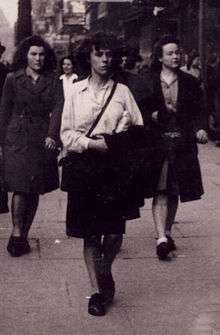Françoise Taylor
| Françoise Taylor | |
|---|---|
 Françoise Taylor , Brussels, late 1930s | |
| Born |
1 January 1920 Liège |
| Died |
24 January 2007 (aged 87) Bolton |
| Known for | Illustrating, Drawing, Painting |
| Website |
www |
Françoise Taylor (née Wauters) was a Belgian artist (1 January 1920 – 24 January 2007).
She studied art at the Académie Royale, Brussels and as a postgraduate at the Ecole Nationale Supérieure d'Architecture et d'Arts Decoratifs, Brussels.[1] In her undergraduate course, Françoise excelled and won First Prize for Drawing in three out of four years. At the Ecole Nationale Supérieure d'Architecture et d'Arts Decoratifs (La Cambre) she specialised in engraving, book illustration, and typography and was awarded a Diploma with the Highest Distinction. Her tutor at La Cambre was Joris Minne.[2] The award of the diploma led to a grant for a further two years work, to produce a portfolio of drawings and engravings. For this, Françoise Wauters was awarded the Master's degree for Book Illustration. This period of study included the Second World War years (1939 - 1945), during most of which Brussels was occupied by German forces.
Her experience of living throughout the German Occupation was reflected in her series of engravings 'Pointes Seches sur la Guerre'. These engravings depict day to day life in Brussels during the war years, as well as Deportations and the Allied Bombardment. These engravings are now part of the permanent collection of the Whitworth Art Gallery, Manchester.
From and early stage, Françoise' studies were heavily influenced by literature. As well as producing engravings for works by Kafka, Dostoievski and Conrad, she drew illustrations for Alice in Wonderland (Carroll), The Rime of the Ancient Mariner (Coleridge) and Morte d'Arthur (Malory).[3] Many of her illustrations for pieces of English Literature were drawn before her subsequent move to England and before she could speak English.
Françoise moved to England in 1946 following her marriage to Kenneth Taylor. She lived in Oxford for 2 years, during which time she completed work started in Belgium and illustrated the book 'Oxfordshire' by Reginald Turnor.[4] She then moved to Bolton in the North of England where she lived for the rest of her life. During the 1950s she produced a collection of drawings and watercolours inspired by her life in the Industrial North. This collection of work provides a unique pictorial record of the buildings, parks and life in the North of England throughout this period. A 1966 Street Scene, Bolton, is part of the Whitworth Gallery collection.[5] A painting of The Crescent, Bolton is part of the Bolton Museum and Art Gallery Collection.[6] A review of her work at this time refers to 'the line and wash drawings which are notable for their poetry and their decorative qualities.' (Anthony Tucker, The Guardian).
Francoise Taylor continued to work as an artist into the 1990s. She held exhibitions in Brussels, Liège, Manchester, Salford and Bolton and her works have been exhibited in London, Paris and other cities. Most of her etchings are in the permanent collection in the Cabinet des Estampes in Brussels and several in the Cabinet des Estampes in Paris.
References
- ↑ Taylor, Patrick (2013). "Françoise Taylor". patricktaylor.com. Retrieved 12 September 2013.
- ↑ Taylor, Patrick (2013). "The Wauters Family-1". patricktaylor.com. Retrieved 16 September 2013.
- ↑ "Arthurian Legend - Le Morte d'Arthur in pictures". arthurian-legend.com. 2013. Retrieved 12 September 2013.
- ↑ Oxfordshire by Reginald Turnor; drawings by Francoise Taylor 1949, Published - London - Paul Elek
- ↑ "Object Display (The University of Manchester)". whitworth.manchester.ac.uk. 2013. Retrieved 12 September 2013.
- ↑ "BBC - Your Paintings - The Crescent, Bolton". bbc.co.uk. 2013. Retrieved 12 September 2013.